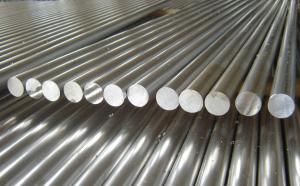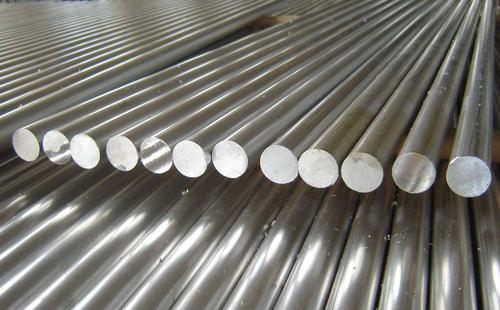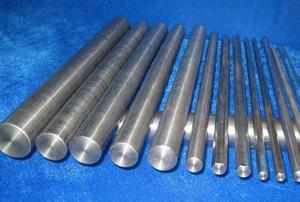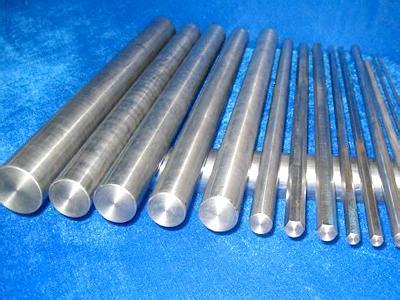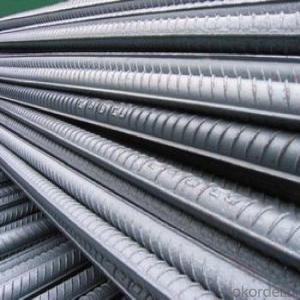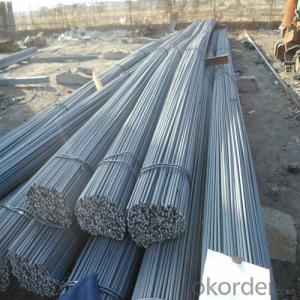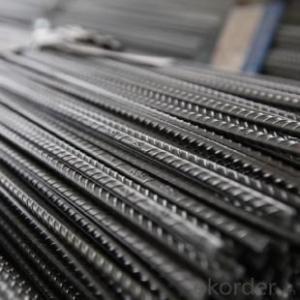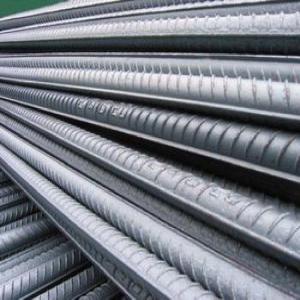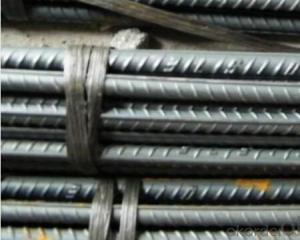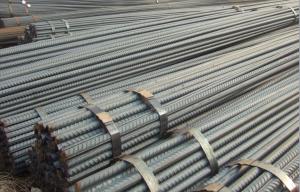Deformed Bar HRB500 HRB400 High Quality Hot Rolled 6mm-50mm BS4449
- Loading Port:
- China Main Port
- Payment Terms:
- TT or LC
- Min Order Qty:
- -
- Supply Capability:
- -
OKorder Service Pledge
OKorder Financial Service
You Might Also Like
Product Description:
OKorder is offering high quality Hot Rolled Steel I-Beams at great prices with worldwide shipping. Our supplier is a world-class manufacturer of steel, with our products utilized the world over. OKorder annually supplies products to European, North American and Asian markets. We provide quotations within 24 hours of receiving an inquiry and guarantee competitive prices.
Product Applications:
Deformed bar is widely used in buildings, bridges, roads and other engineering construction. Big to highways, railways, bridges, culverts, tunnels, public facilities such as flood control, dam, small to housing construction, beam, column, wall and the foundation of the plate, deformed bar is an integral structure material. With the development of world economy and the vigorous development of infrastructure construction, real estate, the demand for deformed bar will be larger and larger
Product Advantages:
OKorder's Steel I-Beams are durable, strong, and resist corrosion, exact size, regular package, chemical and mechanical properties are stable.
Main Product Features:
· Premium quality
· Prompt delivery & seaworthy packing (30 days after receiving deposit)
· Corrosion resistance
· Can be recycled and reused
· Mill test certification
· Professional Service
· Competitive pricing
Product Specifications:
Manufacture: Hot rolled
Grade: BS4449
Certificates: ISO, SGS, BV, CIQ
Diameter: 6mm,8mm,10mm,12mm,14mm,16mm,18mm,20mm,
22mm,25mm,28mm,32mm,36mm,40mm,50mm
Length: 6M, 9M,12M or as required
Packaging: Export packing, nude packing, bundled
Chemical Composition: (Please kindly find our chemistry of our material based on HRB500 as below for your information)
Grade | Technical data of the original chemical composition (%) | ||||||
C | Mn | Si | S | P | V | ||
HRB400 | ≤0.25 | ≤1.60 | ≤0.80 | ≤0.045 | ≤0.045 | 0.04-0.12 | |
Physical capability | |||||||
Yield Strength (N/cm²) | Tensile Strength (N/cm²) | Elongation (%) | |||||
≥400 | ≥570 | ≥14 | |||||
Theoretical weight and section area of each diameter as below for your information:
Diameter(mm) | Section area (mm²) | Mass(kg/m) | Weight of 12m bar(kg) |
6 | 28.27 | 0.222 | 2.664 |
8 | 50.27 | 0.395 | 4.74 |
10 | 78.54 | 0.617 | 7.404 |
12 | 113.1 | 0.888 | 10.656 |
14 | 153.9 | 1.21 | 14.52 |
16 | 201.1 | 1.58 | 18.96 |
18 | 254.5 | 2.00 | 24 |
20 | 314.2 | 2.47 | 29.64 |
22 | 380.1 | 2.98 | 35.76 |
25 | 490.9 | 3.85 | 46.2 |
28 | 615.8 | 4.83 | 57.96 |
32 | 804.2 | 6.31 | 75.72 |
36 | 1018 | 7.99 | 98.88 |
40 | 1257 | 9.87 | 118.44 |
50 | 1964 | 15.42 | 185.04 |
FAQ:
Q1: How soon can we receive the product after purchase?
A1: Within three days of placing an order, we will begin production. The specific shipping date is dependent upon international and government factors, but is typically 7 to 10 workdays.
Q2: What makes stainless steel stainless?
A2: Stainless steel must contain at least 10.5 % chromium. It is this element that reacts with the oxygen in the air to form a complex chrome-oxide surface layer that is invisible but strong enough to prevent further oxygen from "staining" (rusting) the surface. Higher levels of chromium and the addition of other alloying elements such as nickel and molybdenum enhance this surface layer and improve the corrosion resistance of the stainless material.
Q3: Can stainless steel rust?
A3: Stainless does not "rust" as you think of regular steel rusting with a red oxide on the surface that flakes off. If you see red rust it is probably due to some iron particles that have contaminated the surface of the stainless steel and it is these iron particles that are rusting. Look at the source of the rusting and see if you can remove it from the surface.
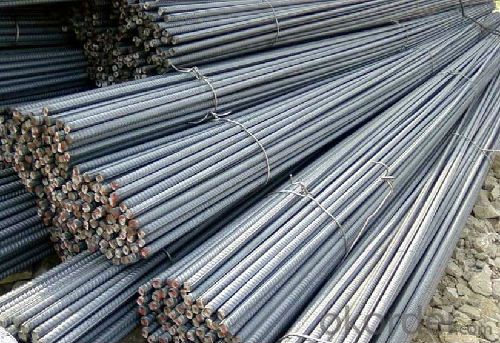
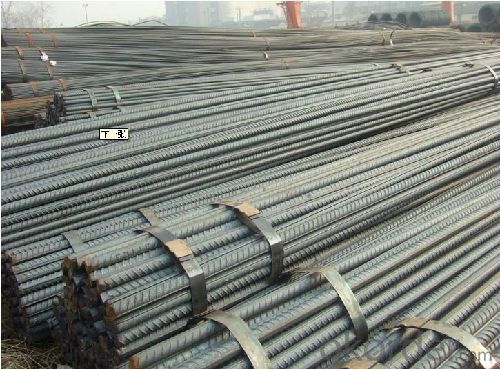
- Q: Can steel rebars be used in the construction of shopping centers?
- Yes, steel rebars can be used in the construction of shopping centers. Steel rebars are commonly used in reinforced concrete structures, including commercial buildings like shopping centers, as they provide strength, durability, and resistance to structural forces.
- Q: What is the role of steel rebars in industrial chimney construction?
- Steel rebars play a crucial role in industrial chimney construction, as they provide reinforcement and strength to the structure. They help in distributing the weight and load of the chimney, ensuring its stability and durability. Additionally, rebars also help to prevent cracks and structural failures by enhancing the overall integrity of the chimney, making it capable of withstanding extreme weather conditions and other external forces.
- Q: What is the process of bending steel rebars into shapes other than straight bars?
- The process of bending steel rebars into shapes other than straight bars involves several steps and techniques. Firstly, the rebars need to be measured and marked to indicate the desired bending points and angles. This is usually done using a measuring tape, a square, and a marker. Next, the rebars are secured in a bending machine or a manual bending tool. The bending machine consists of two main components - a bending head and a bending table. The rebars are placed on the bending table, and the bending head is adjusted to the desired angle and position. Once the rebars are securely positioned, the bending process begins. For smaller rebars, manual tools such as a rebar bender or a rebar cutter can be used. These tools allow the worker to apply force and bend the steel rebar to the desired shape. For larger rebars or complex shapes, a hydraulic bending machine is often employed. This machine uses hydraulic pressure to bend the rebars, allowing for greater precision and control. The operator can adjust the angle and radius of the bend to achieve the desired shape. During the bending process, it is important to ensure that the rebars are not overstressed or damaged. Excessive bending can weaken the rebars and compromise their structural integrity. Therefore, it is crucial to follow the bending specifications and guidelines provided by engineers and construction standards. After the rebars have been bent to the desired shape, they are typically inspected for any defects or imperfections. This is done to ensure that the rebars meet the required standards and can be safely used in construction projects. In conclusion, the process of bending steel rebars into shapes other than straight bars involves measuring and marking, securing the rebars in a bending machine, applying force or hydraulic pressure to bend the rebars, and inspecting the final product for quality assurance. This process requires precision, skill, and adherence to safety guidelines to ensure the rebars can withstand the intended structural loads.
- Q: What is the process of connecting steel rebars to structural members?
- The process of connecting steel rebars to structural members involves several steps to ensure a secure and reliable connection. Firstly, the rebars, which are typically long, steel bars with ridges or deformations on their surface, need to be accurately positioned within the structural member according to the design specifications. This is often done by using spacers or chairs to maintain the proper spacing between the rebars and the surrounding formwork. Next, the rebars are joined to the structural member using various methods. One common method is through lap splicing, where the rebars are overlapped for a certain distance and then tied together using wire or mechanical connectors. The length of the overlap is determined by engineering calculations to ensure sufficient strength and load transfer. Another method is the use of mechanical couplers, which are pre-fabricated devices that provide a reliable connection between rebars. These couplers are designed to grip the rebars tightly and transfer the load effectively. They offer advantages such as faster installation, reduced labor costs, and improved structural integrity. In addition to splicing, the rebars may also need to be anchored or hooked into the structural member. Anchoring involves extending the length of the rebar beyond the connection point and then bending it back into the concrete, creating a hook shape. This provides additional resistance to the pull-out forces. Throughout the process, it is crucial to ensure that the rebars are clean, free from rust, and properly aligned. Any contaminants or misalignments can weaken the connection and compromise the structural integrity. Therefore, thorough inspection and quality control measures are essential to ensure a successful connection. Overall, the process of connecting steel rebars to structural members involves careful planning, accurate positioning, proper splicing or coupling, and thorough inspection. By following these steps, a strong and durable connection can be achieved, ensuring the safety and stability of the structure.
- Q: How do steel rebars help in preventing cracks in concrete structures?
- Steel rebars help in preventing cracks in concrete structures by providing reinforcement and increasing the tensile strength of the concrete. Concrete is strong in compression but weak in tension. When exposed to forces that cause tension, such as bending or stretching, concrete tends to crack. Steel rebars, which are embedded within the concrete, act as a support system and resist the tensile forces, preventing or minimizing cracks. The rebars distribute the stress across the structure, enhancing its overall durability and preventing failure.
- Q: Can steel rebars be used in precast concrete walls?
- Yes, steel rebars can be used in precast concrete walls. The presence of rebars helps to reinforce the concrete and increase its strength and durability. Rebars are commonly used in precast concrete walls to provide structural integrity and resist the forces acting on the wall.
- Q: What are the advantages of using corrosion-resistant steel rebars?
- There are several advantages of using corrosion-resistant steel rebars in construction projects. Firstly, corrosion-resistant steel rebars offer enhanced durability and longevity. Regular steel rebars are prone to corrosion when exposed to moisture and chemicals, which can significantly reduce their lifespan. However, corrosion-resistant steel rebars are specifically designed to resist corrosion, ensuring a longer service life for the structure. This is particularly beneficial in environments with high humidity, coastal areas, or regions with high levels of pollution. Secondly, the use of corrosion-resistant steel rebars helps in maintaining the structural integrity of the building. Corrosion can weaken the rebars, leading to structural failures and safety hazards. By using corrosion-resistant steel rebars, the risk of corrosion-induced structural damage is minimized, ensuring the safety of the occupants and the overall stability of the structure. Additionally, the maintenance costs associated with corrosion-resistant steel rebars are significantly lower compared to regular steel rebars. Structures built with regular steel rebars require frequent inspections, repairs, and maintenance to prevent and address corrosion issues. However, corrosion-resistant steel rebars reduce the need for such maintenance, resulting in reduced costs over the lifespan of the structure. Furthermore, corrosion-resistant steel rebars offer increased flexibility in design and construction. The properties of these rebars allow for the construction of thinner and lighter structures without compromising on strength. This can lead to cost savings in terms of materials and construction time, making corrosion-resistant steel rebars a cost-effective solution. Lastly, the use of corrosion-resistant steel rebars contributes to sustainable construction practices. By increasing the lifespan of the structure and reducing the need for maintenance, the environmental impact of the construction project is minimized. Additionally, the use of these rebars can contribute to obtaining green building certifications, promoting sustainable and environmentally-friendly construction practices. In conclusion, the advantages of using corrosion-resistant steel rebars include enhanced durability, improved structural integrity, reduced maintenance costs, increased design flexibility, and promoting sustainable construction practices.
- Q: What is the purpose of using stirrups with steel rebars?
- The purpose of using stirrups with steel rebars is to provide additional strength and stability to reinforced concrete structures. Stirrups, which are typically U-shaped or circular, are placed around the vertical rebars to prevent them from buckling or collapsing under tension. They help distribute the load evenly across the entire structure, enhancing its durability, resistance to bending, and overall structural integrity.
- Q: What are the different methods of protecting steel rebars against corrosion?
- There are multiple methods available for safeguarding steel rebars from corrosion, which can be broadly categorized into passive and active protection. Passive protection methods involve using barrier coatings or inhibitors to prevent corrosive agents from reaching the surface of the steel rebars. One commonly used technique is applying epoxy coatings, which create a physical barrier between the rebar and its surrounding environment. These coatings can be administered through spraying, brushing, or immersion, and offer excellent corrosion protection. Another passive protection method is utilizing zinc-based coatings like galvanization or zinc-rich paints. These coatings provide sacrificial protection, where the zinc layer corrodes first, thereby shielding the steel rebar from corrosive elements. Galvanization, a widely adopted technique, involves immersing the rebar in molten zinc to form a protective layer. In addition to barrier coatings, inhibitors can also be employed to protect steel rebars. Inhibitors work by reducing the corrosive activity of the surrounding environment. Common inhibitors include calcium nitrite, which forms a protective layer on the rebar's surface, and organic compounds such as amines and phosphates, which passivate the steel and decrease corrosion rates. Active protection methods involve using impressed current cathodic protection (ICCP) or galvanic anodes. ICCP entails applying a direct electrical current to the steel rebar, counteracting the corrosive forces. This technique necessitates the installation of anodes and a power supply system. On the other hand, galvanic anodes are sacrificial metals like aluminum or magnesium that are connected to the steel rebar. The anode corrodes instead of the rebar, offering protection. It is important to consider various factors, including the environment, exposure conditions, and project requirements, when selecting a protection method. Consulting corrosion experts or engineers is often recommended to determine the most suitable method for safeguarding steel rebars from corrosion in a specific situation.
- Q: Can steel rebars be used in combination with other reinforcement materials?
- Yes, steel rebars can be used in combination with other reinforcement materials such as fibers, wire mesh, or carbon fiber sheets to enhance the overall strength and durability of concrete structures. This combination of reinforcement materials provides a more effective solution for reinforcing concrete and can meet specific project requirements.
Send your message to us
Deformed Bar HRB500 HRB400 High Quality Hot Rolled 6mm-50mm BS4449
- Loading Port:
- China Main Port
- Payment Terms:
- TT or LC
- Min Order Qty:
- -
- Supply Capability:
- -
OKorder Service Pledge
OKorder Financial Service
Similar products
Hot products
Hot Searches
Related keywords
